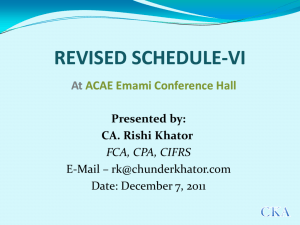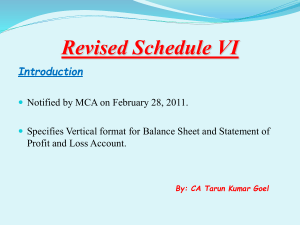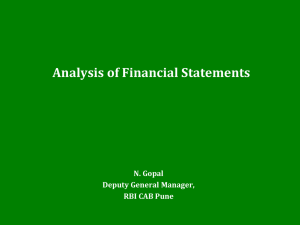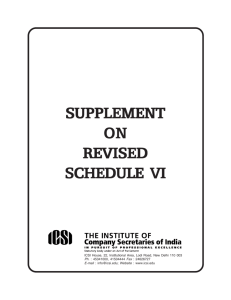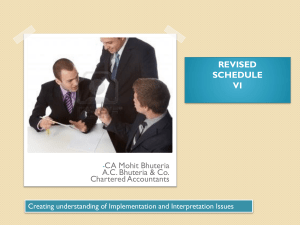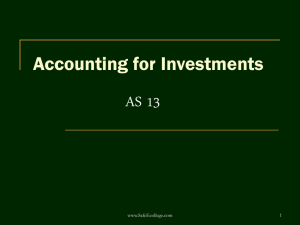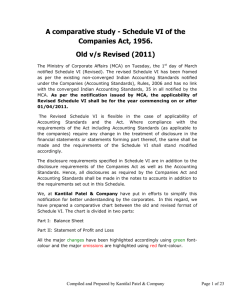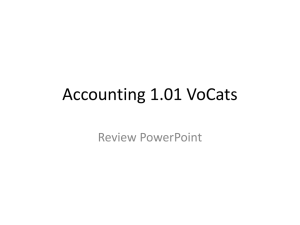Revised Sch. VI- - Comptroller and Auditor General of India
advertisement
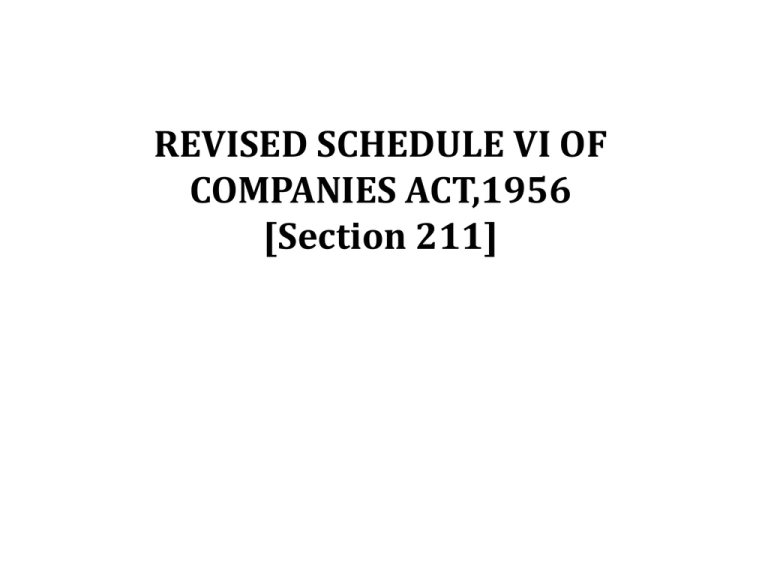
REVISED SCHEDULE VI OF COMPANIES ACT,1956 [Section 211] Background and legal standing Need for enhancing disclosures, harmonising proposed Indian Accounting Standards. with Not applicable to insurance or banking company, or any company engaged in the generation or supply of electricity. Sec. 211 of the Act – “in the form set out in Part I of Schedule VI or as near thereto as circumstances admit”. Modifications to format possible to suit industry specific disclosures. Notification No. S.O. 447(E), dated 28th February 2011 Applicability period mentioned as “For the F.Y. 2010-2011” Lack of clarity and difficulty in application Background and legal standing Amendment to Notification No. S.O. 447(E) by way of Notification No. S.O. 653(E) dated 30th March 2011 Deletion of applicability line and clarity in applicability criteria. Revised Schedule VI shall now come into force for the Balance Sheet and Profit and Loss Account to be prepared for the financial year commencing on or after 1.4.2011 Clarification vide General Circular no.62/2011 dated 5th September 2011 Limited purpose of IPO/FPO during 2011-2012, old Schedule VI may be applied. For periods beyond March 2012, new Schedule VI to mandatorily take effect. Background and legal standing Interim results of listed companies – SEBI has issued new format of disclosure of interim results on 16th April 2012 in line with Revised Schedule VI. Guidance Note to the Revised Schedule VI to the Companies Act,1956 by ICAI – Finalised Dec 2011. STRIKING DISTINCTIONS “Format” of Profit & Loss Account introduced. Horizontal format of BS, PL no longer permitted. Current and non-current classification introduced for presentation of assets and liabilities – Liquidity based approach vis-à-vis security based approach. Appropriations not reflected in P&L. Instead to be disclosed as a part of Reserves and Surplus. Overriding status of AS clearly Definitions to be drawn from AS. laid down. STRIKING DISTINCTIONS Concept of Schedules for break up of amounts done away with, referencing in Notes to Accounts introduced. “Each” item in the BS, PL to be cross referenced with “any” related information. Balance to be maintained while making disclosures. Explicit requirement that same unit of measurement be used in BSPL and Notes. Materiality to be considered in making disclosures. Particulars Note No I. EQUITY AND LIABILITIES (1) Shareholder's Funds (a) Share Capital (b) Reserves and Surplus (c) Money received against share warrants (2) Share application money pending allotment (3) Non-Current Liabilities (a) Long-term borrowings (b) Deferred tax liabilities (Net) (c) Other Long term liabilities (d) Long term provisions (4) Current Liabilities (a) Short-term borrowings (b) Trade payables (c) Other current liabilities (d) Short-term provisions Total Figures as at the end Figures as at the end of of current reporting the previous reporting period period II. Assets (1) Non-current assets (a) Fixed assets (i) Tangible assets (ii) Intangible assets (iii) Capital work-in-progress (iv) Intangible assets under development (b) Non-current investments (c) Deferred tax assets (net) (d) Long term loans and advances (e) Other non-current assets (2) Current assets (a) Current investments (b) Inventories (c) Trade receivables (d) Cash and cash equivalents (e) Short-term loans and advances (f) Other current assets Total BALANCE SHEET - LIABILITIES SHARE CAPITAL Details of authorised, issued, subscribed, paid up capital, par value per share Reconciliation of opening and closing balances Rights, preferences, restrictions attached to each class Shares held by holding or subsidiaries of holding company Names of shareholders holding shares > 5% Shares reserved for issue under options etc. For five years immediately preceding the date as at which the Balance-Sheet is prepared • Details of Bonus shares, shares for non-cash consideration • Details of shares bought back. Terms of any securities convertible into equity/preference shares Calls unpaid by Directors and officers and Forfeited shares BALANCE SHEET - LIABILITIES BALANCE SHEET - LIABILITIES RESERVES AND SURPLUS Classified into and additions / deductions since last balance sheet in: • Capital Reserves • Capital Redemption Reserve • Securities Premium Reserve • Debenture Redemption Reserve • Revaluation Reserve • Share Options Outstanding Account • Other Reserves – specifying the nature, purpose and amount • Surplus i.e. balance in Profit & Loss account disclosing allocations and appropriations A reserve specifically represented by earmarked investments shall be termed as a ‘fund’ Debit balance of profit and loss to be shown as a negative figure under ‘Surplus’. Balance of ‘Reserves and Surplus’, after adjusting negative balance of surplus, if negative, shall still be shown under ‘Reserves and Surplus’ BALANCE SHEET - LIABILITIES MONEY RECEIVED AGAINST SHARE WARRANTS Share Warrants – Financial instruments that give the holder the right to acquire equity shares. Ultimately would form part of Share Capital, but disclosed separately SHARE APPLICATION MONEY PENDING ALLOTMENT Not exceeding issued capital and to the extent not refundable to be disclosed here. Following disclosures also required • Terms and conditions of issue, number of shares, premium amount. • Period before which shares are to be allotted. • Whether the company has enough authorised capital to cover the new shares. • Period for which application money is pending with reasons for the same. NORMAL OPERATING CYCLE Operating Cycle – time between acquisition of assets for processing and their realisation in cash or cash equivalent. May overlap with normal working capital cycle. “Normal operating cycle” – In case of abnormal economic conditions, uneven business variations, classification criteria should not change. Classifications based on normal / ordinary economic conditions. Where normal operating cycle cannot be identified, it is assumed to have a duration of 12 months. Management has to make reasonable judgment about operating cycle. Multiple businesses – Normal operating cycle separately identified for every line of business. CURRENT ASSETS / LIABILITIES CURRENT ASSETS If any of following is satisfied • Expected to be realised or intended to be held for sale or consumption in the company’s normal operating cycle • Held primarily for the purpose of being traded; • Expected to be realised within twelve months after the reporting date; • It is cash or cash equivalent unless restricted for atleast 12 months from the reporting date CURRENT LIABILITIES If any of the following is satisfied • Expected to be settled in the company’s normal operating cycle; • Held primarily for the purpose of being traded; • Due to be settled within 12 months after the reporting date; • No unconditional right to defer settlement at least 12 months from reporting date. • Settlement in equity will not affect classification. BALANCE SHEET - LIABILITIES NON-CURRENT LIABILITIES LONG TERM BORROWINGS Classified into• Bonds/debentures (alongwith details of ROI, redemption dates etc) Presented in descending order of maturity, farthest first and so on. Particulars of redeemed bonds with power to reissue to be disclosed. • Term loans – From Banks and other parties – Terms of repayment to be stated • Deferred payment liabilities. • Deposits • Loans and advances from related parties • Long term maturities of finance lease obligations • Other loans and advances (specify nature) Borrowings shall further be sub-classified as secured and unsecured. Nature of security (i.e. Mortgage, Pledge & Hypothecation) shall be specified separately in each case. BALANCE SHEET - LIABILITIES NON-CURRENT LIABILITIES LONG TERM BORROWINGS Aggregate amount of loans guaranteed by Directors or others to be separately disclosed. (not restricted to related parties, but any person) Period and amount of continuing default as on BS date to be stated in each case of repayment of loans. No need to disclose other defaults. NON-CURRENT LIABILITIES OTHER LONG TERM LIABILITIES. To be classified into Trade Payables and Others NON-CURRENT LIABILITIES LONG TERM PROVISIONS To be classified into Provisions for Employee Benefits and others BALANCE SHEET - LIABILITIES CURRENT LIABILITIES SHORT TERM BORROWINGS Short-term borrowings shall be classified as: • Loans repayable on demand – From Banks and other parties • Loans and advances from related parties. • Deposits. • Other loans and advances (specify nature). Borrowings shall further be sub-classified as secured and unsecured. Nature of security (i.e. Mortgage, Pledge & Hypothecation) shall be specified separately in each case. Aggregate amount of loans guaranteed by Directors and others to be separately disclosed. Period and amount of default as on BS date to be stated in each case of repayment of loans. BALANCE SHEET - LIABILITIES CURRENT LIABILITIES TRADE PAYABLES Classified as trade payables if it is in respect of the amount due on account of goods purchased or services received in the normal course of business. CURRENT LIABILITIES OTHER CURRENT LIABILITIES Current maturities of long term debt Current maturities of finance lease obligations Interest accrued but not due on borrowings Interest accrued and due on borrowings Income received in advance Unpaid dividends Application money for allotment of securities due for refund • Meaning of “advances towards allotment” is unclear. • Terms of issue, number of shares, premium, period before which shares will be allotted to be disclosed. • Disclosure of sufficiency of authorised capital to cover the share application BALANCE SHEET - LIABILITIES CURRENT LIABILITIES OTHER CURRENT LIABILITIES Application money for allotment of securities due for refund • Period and reasons for which share application money is pending to be disclosed. • Share application money not exceeding issued capital to form part of Equity, over and above should form part of current liabilities. Unpaid Matured deposits and interest accrued thereon Unpaid Matured debentures and interest accrued thereon Other payables disclosing its nature. CURRENT LIABILITIES SHORT TERM PROVISIONS Provision for employee benefits Others disclosing its nature – Prov. For income tax, Prov. For warranties etc. BALANCE SHEET - ASSETS NON-CURRENT ASSETS FIXED ASSETS Tangible Assets – to be classified as: • Land • Building • Plant and Equipment • Furniture and Fixtures • Vehicles • Office Equipment • Others (nature to be disclosed) Intangible Assets – to be classified as: • Goodwill • Brands /trademarks. • Computer software • Mastheads and publishing titles • Mining rights. • Copyrights, patents and other IPR, services and operating rights. • Recipes, formulae, models, designs and prototypes. • Licenses and franchise • Others (specify nature) BALANCE SHEET - ASSETS NON-CURRENT ASSETS FIXED ASSETS Within tangible Assets, assets under lease to be disclosed separately for each class. For both, tangible and intangible assets • Reconciliation of carrying amounts at the beginning and at the end of the reporting periods to be given. • Additions, disposals, acquisitions through business combinations, other adjustments, depreciation/amortisation and impairment losses /reversals to be disclosed • Sums written off or added on revaluation of assets to be disclosed by way of a note for first 5 years subsequent to the date of such increase / decrease. BALANCE SHEET - ASSETS NON-CURRENT ASSETS NON CURRENT INVESTMENTS Non-current investments shall be classified as trade investments and other investments and further classified as: • Investment property • Investments in Equity Instruments • Investments in preference shares • Investments in Government or trust securities • Investments in debentures or bonds • Investments in Mutual Funds • Investments in partnership firms • Other non-current investments (specify nature) Names of bodies corporate in which investments are made to be disclosed – indicating if these are subsidiaries, JVs or controlled SPEs. Names of firms in which investments made also to be disclosed along with names of all partners. Separate disclosure of investments carried at other than cost and its basis. Aggregate amount of quoted investments and its market value, unquoted investments and provision for diminution in value to be separately disclosed. BALANCE SHEET - ASSETS NON-CURRENT ASSETS LONG-TERM LOANS AND ADVANCES Long-term loans and advances shall be classified as: • Capital Advances • Security Deposits • Loans and advances to related parties (giving details thereof); • Other loans and advances (specify nature). Separately classification of above items into Secured, considered good, Unsecured, considered good and Doubtful also to be made. Allowance for bad and doubtful loans and advances shall be disclosed under the relevant heads separately. Loans and advances due by directors or other officers of the company or any of them either severally or jointly with any other persons or amounts due by firms or private companies respectively in which any director is a partner or a director or a member should be separately stated. BALANCE SHEET - ASSETS NON-CURRENT ASSETS OTHER NON-CURRENT ASSETS Other non-current assets to be classified as: • Long term trade receivables • Others disclosing its nature Separately classification of long term trade receivables into Secured, considered good, Unsecured, considered good and Doubtful also to be made. Allowance for bad and doubtful loans and advances shall be disclosed under the relevant heads separately. Debts due by directors or other officers of the company or any of them either severally or jointly with any other persons or debts due by firms or private companies respectively in which any director is a partner or a director or a member should be separately stated. BALANCE SHEET - ASSETS CURRENT ASSETS CURRENT INVESTMENTS Current investments shall be classified as: • Investments in Equity Instruments • Investments in preference shares • Investments in Government or trust securities • Investments in debentures or bonds • Investments in Mutual Funds • Investments in partnership firms • Other non-current investments (specify nature) Names of bodies corporate in which investments are made to be disclosed – indicating if these are subsidiaries, JVs or controlled SPEs. Names of firms in which investments made also to be disclosed along with names of all partners. Separate disclosure of basis of valuation of individual investments to be made. Aggregate amount of quoted investments and its market value, unquoted investments and provision for diminution in value to be separately disclosed. BALANCE SHEET - ASSETS CURRENT ASSETS INVENTORIES Inventories to be classified as • Raw materials • Work in progress • Finished goods • Stock-in-trade (for trading business) • Stores and spares • Loose tools • Others For all above heads, goods in transit, if any, to be disclosed separately. Mode of valuation of inventories to be stated. BALANCE SHEET - ASSETS CURRENT ASSETSTRADE RECEIVABLES Aggregate amount of Trade Receivables outstanding for a period exceeding six months from the date they are due for payment should be separately stated. Separately classification of trade receivables into Secured, considered good, Unsecured, considered good and Doubtful also to be made. Allowance for bad and doubtful loans and advances shall be disclosed under the relevant heads separately. Debts due by directors or other officers of the company or any of them either severally or jointly with any other persons or debts due by firms or private companies respectively in which any director is a partner or a director or a member should be separately stated. BALANCE SHEET - ASSETS CURRENT ASSETSCASH AND CASH EQUIVALENTS Cash and cash equivalents shall be classified as: • Balances with banks • Cheques, drafts on hand • Cash on hand • Others (specify nature). Earmarked balances with banks (for example, for unpaid dividend) shall be separately stated. Balances with banks to the extent held as margin money or security against the borrowings, guarantees, other commitments shall be disclosed separately. Repatriation restrictions, if any, in respect of cash and bank balances shall be separately stated. Bank deposits with more than 12 months maturity shall be disclosed separately. BALANCE SHEET - ASSETS CURRENT ASSETS SHORT-TERM LOANS AND ADVANCES Short-term loans and advances shall be classified as: • Loans and advances to related parties (giving details thereof); • Other loans and advances (specify nature). Separately classification of above items into Secured, considered good, Unsecured, considered good and Doubtful also to be made. Allowance for bad and doubtful loans and advances shall be disclosed under the relevant heads separately. Loans and advances due by directors or other officers of the company or any of them either severally or jointly with any other persons or amounts due by firms or private companies respectively in which any director is a partner or a director or a member should be separately stated. CURRENT ASSETS OTHER CURRENT ASSETS BALANCE SHEET – OTHER DISCLOSURES CONTINGENT LIABILITIES AND COMMITMENTS Contingent liabilities shall be classified as • Claims against the company not acknowledged as debt • Guarantees • Other money for which the company is contingently liable Commitments shall be classified as • Estimated amount of contracts remaining to be executed on capital account and not provided for • Uncalled liability on shares and other investments partly paid • Other commitments (specify nature). Disclosure about dividends proposed for equity and preference shareholders and related amount per share to be made. Details of unutilised amounts as at Balance Sheet date from an issue of securities to be disclosed EXAMPLE - OTHER COMMITMENTS STATEMENT OF PROFIT AND LOSS Profit and Loss statement for the year ended 31st March, _______ Figures as at the end Figures as at the end Particulars Note No of current reporting of previous reporting period period I. Revenue from operations II. Other Income III. Total Revenue (I +II) IV. Expenses: Cost of materials consumed Purchase of Stock-in-Trade Changes in inventories of finished goods, work-in-progress and Stock-inTrade Employee benefit expense Financial costs Depreciation and amortization expense Other expenses Total Expenses V. Profit before exceptional and extraordinary items and tax (III - IV) VI. Exceptional Items VII. Profit before extraordinary items and tax (V - VI) VIII. Extraordinary Items IX. Profit before tax (VII - VIII) X. Tax expense: (1) Current tax (2) Deferred tax XI. Profit(Loss) from the period from continuing operations (VII-VIII) XII. Profit/(Loss) from discontinuing operations XIII. Tax expense of discounting operations XIV. Profit/(Loss) from Discontinuing operations (XII - XIII) XV. Profit/(Loss) for the period (XI + XIV) XVI. Earning per equity share: (1) Basic (2) Diluted STATEMENT OF PROFIT & LOSS REVENUE Separate disclosure for Revenue from operations of a company other than a finance company • Sale of products • Sale of services • Other operating revenues • Less: Excise duty Revenue from operations of a finance company • Interest; and • Other financial services OTHER INCOME Other income to be classified as • Interest Income (in case of a company other than a finance company) • Dividend Income • Net gain/loss on sale of investments • Other non-operating income (net of expenses directly attributable) FINANCE COMPANY - ILLUSTRATION STATEMENT OF PROFIT & LOSS COST OF MATERIAL CONSUMED Applicable for manufacturing companies Includes Raw materials, packing materials and intermediaries consumed PURCHASE OF STOCK IN TRADE Includes those purchased for the purpose of resale CHANGES IN INVENTORIES Separate disclosures w.r.t finished goods, WIP and stock in trade. FINANCE COSTS Finance costs shall be classified as • Interest expense • Other borrowing costs • Applicable net gain/loss on foreign currency transactions and translation STATEMENT OF PROFIT & LOSS EMPLOYEE BENEFITS EXPENSE Salaries and wages, contribution to provident and other funds, expense on ESOP and ESPP, staff welfare expenses OTHER EXPENSES Expenditure incurred on following items, separately for each item:• Consumption of stores and spare parts • Power and fuel • Rent • Repairs to buildings • Repairs to machinery • Insurance • Rates and taxes, excluding, taxes on income • Miscellaneous expenses Any item of income or expenditure which exceeds one per cent of the revenue from operations or Rs.1,00,000, whichever is higher. STATEMENT OF PROFIT & LOSS ADDITIONAL INFORMATION FOR ALL COMPANIES Net gain/ loss on sale of investments Adjustments to the carrying amount of investments Net gain or loss on foreign currency transaction and translation (other than considered as finance cost) Payments to the auditor as • Auditor • for taxation matters • for company law matters • for management services • for other services • for reimbursement of expenses Details of items of exceptional and extraordinary nature Prior period items Tax Expense – Current tax and Deferred Tax STATEMENT OF PROFIT & LOSS ADDITIONAL INFORMATION - SPECIFIC TYPES OF COMPANIES In case of manufacturing companies • Raw materials under broad heads • goods purchased under broad heads In the case of trading companies • purchases in respect of goods traded in by the company under broad heads. In the case of companies rendering or supplying services • gross income derived form services rendered or supplied under broad heads. In the case of other companies, gross income derived under broad heads. Work in progress under broad heads wherever applicable. STATEMENT OF PROFIT & LOSS FURTHER ADDITIONAL INFORMATION - ALL COMPANIES Material amounts set aside or to be set aside to reserve other than provisions made to meet any specific liability Any amounts withdrawn from such reserves, if material Material amounts set aside to provisions made for meeting specific liabilities Amounts withdrawn from such provisions as no longer required if material Subsidiary companies: • Dividends from subsidiary companies. • Provisions for losses of subsidiary companies. STATEMENT OF PROFIT & LOSS ADDITIONAL INFORMTION IN NOTES Value of imports- C.I.F basis during the financial year in respect of • Raw materials • Components and spare parts • Capital goods Expenditure in foreign currency during the financial year on account of royalty, know-how, professional and consultation fees, interest, and other matters Total value if all imported / indigenous raw materials, spare parts and components consumed during the year and the percentage of each to the total consumption STATEMENT OF PROFIT & LOSS ADDITIONAL INFORMTION IN NOTES The amount remitted during the year in foreign currencies on account of dividends with a specific mention of the total number of non-resident shareholders, the total number of shares held by them on which the dividends were due and the year to which the dividends related – disclosure on cash basis. Earnings in foreign exchange classified under the following heads, namely: • Export of goods calculated on F.O.B. basis • Royalty, know-how, professional and consultation fees • Interest and dividend • Other income, indicating the nature thereof STATEMENT OF PROFIT & LOSS PROFIT / LOSS FROM DISCONTINUING OPERATIONS Disclosure required in line with AS-24 of ICAI On the face of the statement of profit and loss Tax expense / credit in relation to discontinuing operations disclosed separately EARNINGS PER SHARE Disclosure required in line with AS-20 of ICAI. Basic and diluted EPS to be disclosed Even if negative, loss per share to be disclosed Nominal value per share also to be disclosed. DISCLOSURES NO LONGER REQUIRED Disclosures relating to managerial remuneration and computation of net profits for calculation of commission Information relating to licensed capacity, installed capacity and actual production Information on investments purchased and sold during the year Investments, sundry debtors and loans & advances pertaining to companies under the same management Maximum amounts due on account of loans and advances from directors or officers of the company Commission, brokerage and non-trade discounts THANK YOU…
